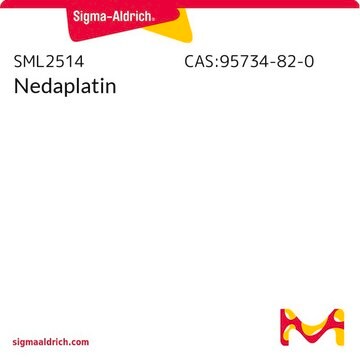O9512
Oxaliplatin
powder
Synonym(s):
[SP-4-2-(1R-trans)]-(1,2-Cyclohexanediamine-N,N′)[ethanedioata(2--)-O,O’]platinum
About This Item
Recommended Products
form
powder
originator
Sanofi Aventis
storage temp.
2-8°C
SMILES string
O=C1O[Pt]OC1=O.N[C@@H]2CCCC[C@H]2N
InChI
1S/C6H14N2.C2H2O4.Pt/c7-5-3-1-2-4-6(5)8;3-1(4)2(5)6;/h5-6H,1-4,7-8H2;(H,3,4)(H,5,6);/q;;+2/p-2/t5-,6-;;/m1../s1
InChI key
ZROHGHOFXNOHSO-BNTLRKBRSA-L
Looking for similar products? Visit Product Comparison Guide
Application
- as a chemotherapeutic agent in colon rectal adenocarcinoma SW480 cells by cell viability assay
- for monitoring cell survival in hepatocellular carcinoma HepG2 and HepG2/R cells by MTT assay
- to determine the growth inhibitory effect on human breast adenocarcinoma MDA-MB-231 cells
Biochem/physiol Actions
Features and Benefits
Signal Word
Danger
Hazard Statements
Precautionary Statements
Hazard Classifications
Carc. 2 - Eye Dam. 1 - Lact. - Muta. 2 - Repr. 1B - Resp. Sens. 1B - Skin Sens. 1 - STOT RE 1
Storage Class Code
6.1C - Combustible acute toxic Cat.3 / toxic compounds or compounds which causing chronic effects
WGK
WGK 3
Flash Point(F)
Not applicable
Flash Point(C)
Not applicable
Personal Protective Equipment
Certificates of Analysis (COA)
Search for Certificates of Analysis (COA) by entering the products Lot/Batch Number. Lot and Batch Numbers can be found on a product’s label following the words ‘Lot’ or ‘Batch’.
Already Own This Product?
Find documentation for the products that you have recently purchased in the Document Library.
Customers Also Viewed
Articles
DNA damage and repair mechanism is vital for maintaining DNA integrity. Damage to cellular DNA is involved in mutagenesis, the development of cancer among others.
Cell cycle phases (G1, S, G2, M) regulate cell growth, DNA replication, and division in proliferating cells.
Cell cycle phases (G1, S, G2, M) regulate cell growth, DNA replication, and division in proliferating cells.
Cell cycle phases (G1, S, G2, M) regulate cell growth, DNA replication, and division in proliferating cells.
Our team of scientists has experience in all areas of research including Life Science, Material Science, Chemical Synthesis, Chromatography, Analytical and many others.
Contact Technical Service













